Panasonic Viera TX-P42G20 42in Plasma TV Review
Panasonic Viera TX-P42G20 42in Plasma TV
Featuring Panasonic's latest NeoPDP tech and two HD tuners, we cast our eyes over this plasma television.
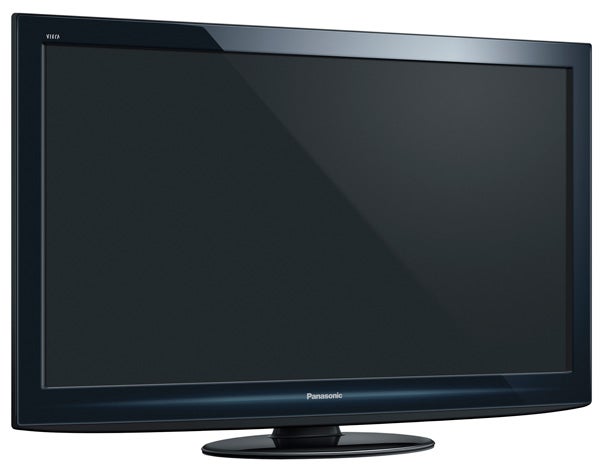
Verdict
Pros
- Dual Freesat/Freeview HD tuners
- Great black levels
- Flawless HD performance
Cons
- Poor USB HDD support
- Could be a little sharper
- Mediocre sound
Key Specifications
- Review Price: £838.90
- 4 HDMIs, one v1.4
- 5,000,000:1 dynamic contrast
- Recording to USB
- 1080p plasma panel
- 20.5kg weight

(centre)Best TV Under £750(/centre)
Regular readers will know that Panasonic’s new G20 plasma series has been on my mind for quite a while now. It impressed me at various shows and press launches and its shadow has hung heavily over the two previous decent but not jaw-dropping 2010 Panasonic plasma TVs I’ve tested. Basically, alongside Panasonic’s upcoming VT20 3D plasmas, the G20 series is the one I’ve been waiting for.
There are a number of reasons why the G20 series seems so appealing. For starters, it’s the first TV in the UK with not one but two HD tuners: one for Freeview HD, and one for Freesat HD. Second, it’s the first Panasonic plasma TV we’ve seen to feature the 2010 version of the brand’s NeoPDP technology. Third, it’s the first TV from Panasonic to support recording to USB HDD. Finally and perhaps best of all, it delivers all this for surprisingly little money; we’ve found the 42in P42G20B model going for a little over £800, which compares very handily with all the LED-lit and top-end CCFL LCD TVs currently vying for your World Cup attention.
We’ll get into some of the P42G20B‘s star attractions in more detail presently, but first, I can’t help but feel disappointed by just how bland the P42G20B looks. It’s a touch glossier and more robust than Panasonic’s equivalent 2009 models, I guess, but its drab, unimaginative lines continue to lag painfully behind the TV designs of Samsung, LG and Philips – to name but three. To dress such a cutting-edge product so plainly feels almost criminal.
Things perk up a bit with the P42G20B’s connections, at least. For instance, of the more than adequate four HDMIs, one is a v1.4 affair, enabling the TV to offer the latest HDMI spec’s audio return channel, so that the TV can send audio data to an AV receiver without the need for a separate digital audio cable.
The set also has an Ethernet port, which serves a whole number of uses. First, it’s there to support the Freeview and Freesat HD platforms, and any future interactive features – including, inevitably, the BBC iPlayer – they might introduce. Next, it allows you to stream in files from a DLNA-capable PC. And finally, it provides your connection to Panasonic’s VieraCast online platform (or, alternatively, you can go Wi-Fi via an optional USB dongle).
Last year, VieraCast was one of the better online services around – not least because of its impressively designed and intuitive interface. But I have to admit to being a touch disappointed with it this year, simply because it hasn’t yet evolved very much. The English-language services available are DailyMotion, YouTube, Picasa, Eurosport, and a weather ‘channel’ – fair enough, I guess, but some way short of what you can enjoy via the latest Sony or Philips online TVs.
As with all online services, though, VieraCast can be updated on the hoof as and when new service provider deals are struck, so hopefully this aspect of the P42G20B’s feature list will improve soon. Our model actually showed a ‘Coming Soon’ menu graphic for Skype, for instance, and we’ve certainly seen examples of streaming movie services at some of the shows and presentations we’ve attended.
The P42G20B’s multimedia features are boosted by its carriage of both SD card and USB slots that can play a wide variety of file types, including MP3/AAC audio, AVCHD, DivX, JPEGs, and MPEG2 video. Plus, as noted earlier, the P42G20B allows you to record footage from the digital tuners to USB HDD hard drives. What’s more, since it records the direct digital video stream, these recordings are essentially identical in quality – with HD or standard def – to the original broadcasts. You can set the TV to buffer video to the USB HDD automatically, too, giving you a handy instant rewind feature.
Which is all great, of course. The problem is that I really struggled to find a USB HDD that would work with the TV. USB sticks aren’t acceptable (your drive needs a capacity of between 160GB and 2TB). And as for USB HDD drives, none of the three I own – an ageing Buffalo drive, a Toshiba Stor.E drive, and a Seagate – worked. So I checked the USB HDD compatibility ‘list’ on Panasonic’s website, and found just one certified solution: the Buffalo JustStore Desktop HD-EU2-UK series. So I had to buy one of these, just so I could put the P42G20B’s recording features through their paces! Grr.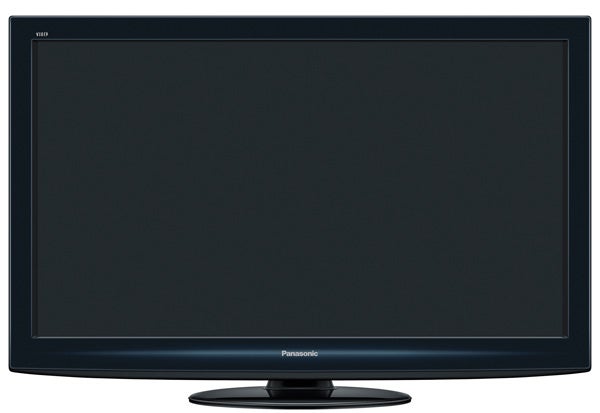
I guess it’s possible that other drives may work with the P42G20B too, but nobody seems to know for sure. Frustrating. Especially given the relative openness of the USB recording system carried by Samsung’s recently tested UE55C8000.
One further, though much more predictable limitation of the P42G20B’s USB HDD recording capability is that the USB drive is tied to the TV, so you can’t take it out and play your recorded content on any other TV or video-capable device.
Interesting though all the P42G20B’s multimedia and recording talents are, for me the TV’s single most important feature is its latest NeoPDP technology. This really does appear to be a wholesale improvement on the previous NeoPDP design, complete with a new filter (something to do with Panasonic’s deal with Pioneer, perhaps?!), better phosphors, a more efficient discharge gas, and even a new cell structure. Let’s hope this proves to be as effective in practice as it sounds on paper.
Panasonic has also tweaked its V-Real Pro video processing engine for the G20 series, bringing it up to generation five. Plus the set boasts Panasonic’s slightly infamous 600Hz system, which rather than actually refreshing the screen 600 times a second as you might expect, instead inserts 12 extra sub-fields for each frame of the actual source image. For a fuller explanation of this, check out the recent review of the Panasonic Viera TX-P50S20B.
Using the latest NeoPDP system has allowed Panasonic to quote a contrast ratio of 5,000,000:1 for the P42G20B versus ‘just’ 2,000,000:1 for last year’s P42G10, while yet another key improvement finds the P42G20B coming with THX endorsement, including a THX-certified picture preset. THX support only appeared higher up Panasonic’s range last year.
And still we’re not done with the P42G20B’s improvements over last year’s G10s. For rather importantly Panasonic has finally managed to get the Imaging Science Foundation on board, by providing enough set-up flexibility to allow an ISF pro to come round and calibrate the TV to best suit your room environment.
Among the key new tools that probably persuaded the ISF to work with Panasonic is a colour management system whereby you can adjust the gain and cut-off settings for each of the red, green and blue colour components. Plus there’s a series of gamma presets, including most notably the key 2.2 setting, and an S-Curve setting which, while not as accurate as the 2.2 mode, can bring out more mid-level detail in a picture if that tickles your fancy.
Other features of note in the P42G20B’s slightly dated-looking but effective onscreen menus include a Resolution Enhancer option, a Vivid Colour option, Panasonic’s Intelligent Frame Creation engine for interpolating extra frames of video to reduce judder, and noise reduction options.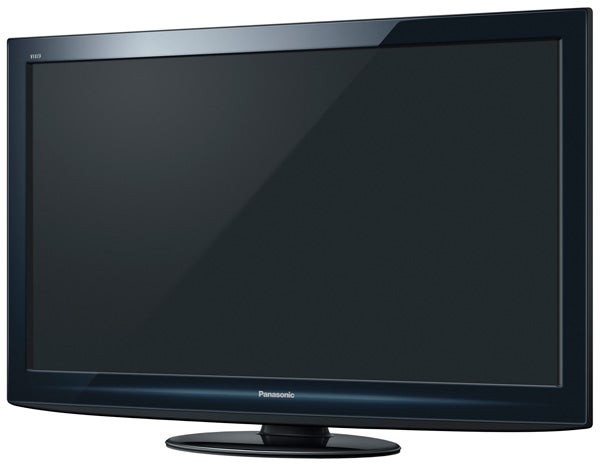
Some of the fine-tuning options listed above really are long overdue on Panasonic plasmas; LG, for instance, has offered such tools for at least a couple of plasma generations now. But the key point is that they’re here now, and really can help make the P42G20B’s very good out-of-the-box picture into a truly excellent one.
The P42G20B’s biggest improvements over the performance of last year’s G10 models – and arguably Panasonic’s excellent V10 models as well – come in two of my favourite picture areas: black level response and colour tone.
When it comes to black levels, they’re pretty much impeccable in terms of both their freedom from the grey clouding so common with flat TVs, and their naturalism. By which I mean that dark parts of the picture are stuffed with subtleties of shade and shadow details to an extent I don’t think I’ve seen before at this market level. There’s none of the usual hollowness and lack of depth usually seen when affordable flat TVs try to produce a good black colour.
A further knock-on benefit of this is that dark scenes thus look completely consistent in terms of depth and ‘style’ with bright scenes, which I would argue actually makes you able to engage much more seamlessly with a typical film.
Also a joy to behold is the consistency of the P42G20B’s black level across its whole screen. There’s absolutely no trace at all of the backlight inconsistencies that plague – to my increasing irritation – almost all current LCD and LED-lit TVs to some extent. Arguably even better still, unlike practically every LCD TV, you can watch this set from almost right angles before there’s any significant deterioration in the picture’s contrast or colour saturation. This makes the set a no-brainer for anyone whose room requires some family members to have to watch TV from the side.
Colours are vastly improved from last year’s affordable Panasonic plasmas in several ways. Most importantly, after a little calibration (in which I even toned down the colour saturation of the THX mode a bit), colour tones are much more consistently natural, even when watching standard definition sources. They’re also more vibrant, giving pictures extra punch.
The fact that Panasonic has managed to squeeze a Full HD pixel count into the P42G20B helps colours too, as colour blends are rendered smoothly and accurately, with only the very occasional appearance of plasma’s once-common colour striping phenomenon.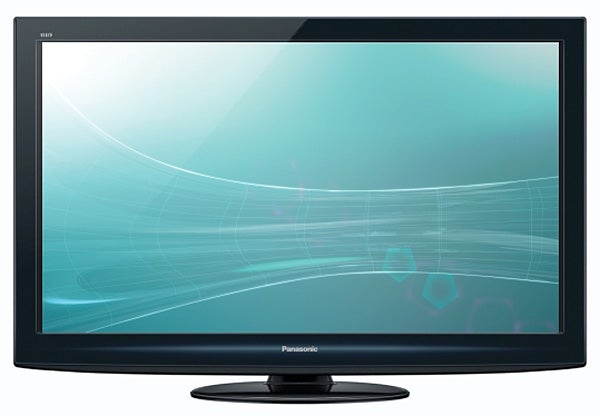
Not surprisingly, the P42G20B’s high resolution also pays dividends when it comes to delivering the sharpness and detail in HD sources. In fact, its performance with good quality Blu-ray discs is borderline flawless for me – or, at least, it’s more cinematic than that of any other flat TV around for the same sort of money.
Yet more good news concerns the P42G20B’s handling of motion. For with the Intelligent Frame Creation or 24p (depending on your source) system turned gently on, there’s only a residual trace of Panasonic’s once quite hefty judder problems. And this is achieved with a bare minimum of unwanted processing side effects, too.
I guess in an ideal world, Panasonic’s standard definition pictures would look a bit sharper – though the new Resolution Enhancer circuit does help this to some extent. Also, people with really bright rooms might find the P42G20B’s pictures a bit lacking in brightness. But really, provided you can control your light levels, there’s nothing very negative to say about the P42G20B’s pictures at all.
Sonically the story isn’t so good, as the P42G20B serves up rather average levels of clarity and dynamic range. But it’s still adequate, and the speakers don’t actually distort even during a high-octane action sequence.
”’Verdict”’
The P42G20B may lack the glamour and panache of many of today’s LCD glory boys, and its realistic approach to pictures might struggle to make its presence felt in a crowded electrical superstore. But don’t let this deceive you. For underneath its uninspiring exterior beats a heart of home cinema gold and a stubborn focus on good, old-fashioned picture accuracy and quality, all for a decent price.
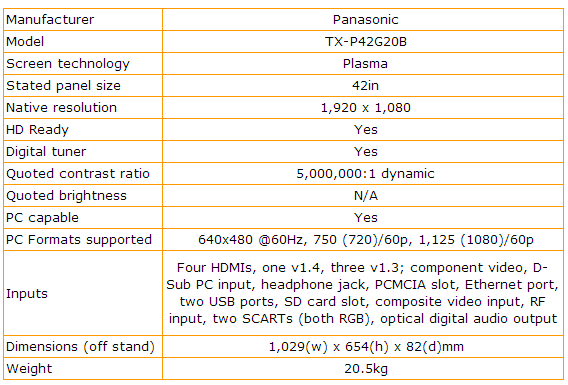
How we test televisions
We test every TV we review thoroughly over an extended period of time. We use industry standard tests to compare features properly. We’ll always tell you what we find. We never, ever, accept money to review a product.
Trusted Score
Score in detail
-
Features 8
-
Value 9
-
Image Quality 9
-
Design 6
-
Sound Quality 8
Features
| Size (Inch) | 42in |
| Display Type | Plasma |
Physical Specifications
| Height (Millimeter) | 59.6mm |
| Width (Millimeter) | 103mm |

